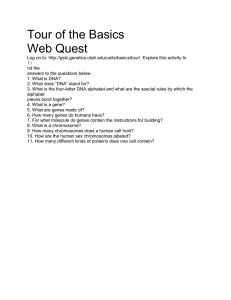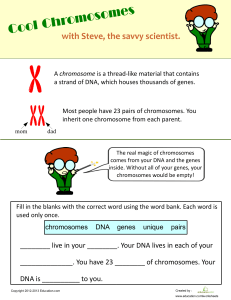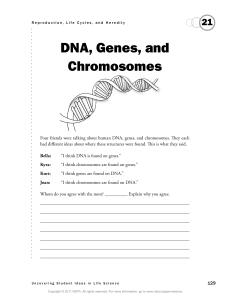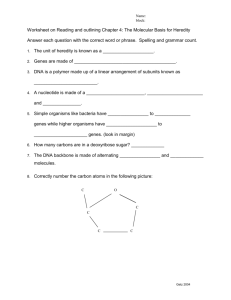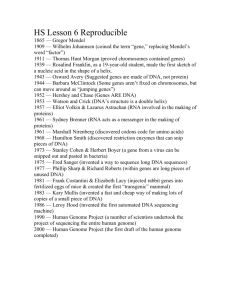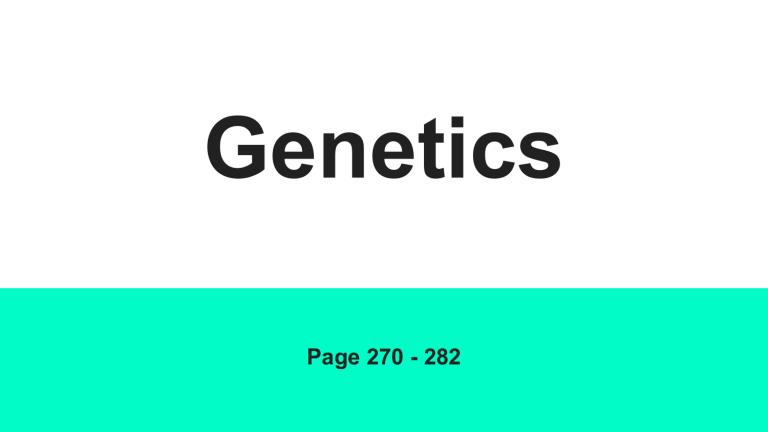
Genetics Page 270 - 282 Key Knowledge By the end of these lessons you should be able to understand: • the distinction between a genome, gene and allele • the genome as the sum total of an organism’s DNA measured in the number of base pairs contained in a haploid set of chromosomes • the role of genomic research since the Human Genome Project, with reference to the sequencing of the genes of many organisms, comparing relatedness between species, determining gene function and genomic applications for the early detection and diagnosis of human diseases. Genes - Deoxyribonucleic acid (DNA) the most common genetic material for all organisms. - What percentage of their genes match yours? Another human? 99.9% - All humans have the same genes, but have variations in sequences to make them unique A chimpanzee? 98% - Chimpanzees have the closest genetic makeup to humans A mouse? 92% A fruit fly? 44% Yeast? 26% - Yeasts are single celled organisms, but have similar genes, such as the gene that enable energy to be derived from the breakdown of sugars A weed? 18% - plants have metabolic differences to humans, but still have similar ‘housekeeping’ genes Genes Heredity is the study of inheritance. It looks at the mechanisms and patterns of inheritance through transmission of coded chemical instruction between generations. Genes represent stretches of DNA that make up a ‘unit’ of genetic information that can be ‘read’ and signal production of a protein. The DNA sequence is the way in which DNA molecules are put together, and are what makes individual genes different. Recap DNA Structure 1. A five-carbon deoxyribose sugar 2. A negatively charged phosphate group linked by phosphodiester bonds 3. A nitrogenous base - Adenine (A) - Thymine (T) - Guanine (G) - Cytosine (C) Hydrogen Bonds and Base Pairing Hydrogen bonds hold the double helix together between the opposing pairs of nitrogenous bases. What is a hydrogen bond? Write down your answer The base pairing rule results in complementary nitrogenous bases being connected by hydrogen bonds. Double Helix Activity Make an origami DNA double helix. Draw the double helix you have created in your workbooks. You must illustrate: - The three chemical components to DNA (deoxyribose sugar, phosphate and nitrogenous bases) - The correct hydrogen bonds Chromosomes DNA and its associated proteins make up chromosomes DNA is coiled around histone proteins to form nucleosomes, then wrapped into chromosomes Chromosomal pairs are matched on size, centromere position and banding pattern Karyotypes The complete set of chromosomes of an organism. Note that chromosomes are arranged into pairs. Each pair are ‘homologous chromosomes’ because they are the same size and shape and code for the same genes. However they may have different alleles. Humans have 22 autosomal pairs and a pair of sex chromsomes for a total of 23 pairs or 46 individuals Identifying chromosomal disorders Karyotyping is used to identify anomalies in that person’s chromosomal make-up. Notably the addition or subtraction of chromosomes. Define: - Monoploidy - Polypoidly - Aneuploidy Identify the error in this individual’s karyotype, explain how it may have occurred and the common name of the condition/syndrome. Define: Genes Genomes Alleles The Genome Story Activity Create a timeline of the Human Genome: - From the discovery of genetics - To the Human Genome Project Completion Resource: https://unlockinglifescode.org/timeline Key Terms: DNA Heredity DNA Sequence Genes Genomes Alleles Human Genome Project Double Helix Hydrogen Bonds Deoxyribose sugar Phosphate Phosphodiester bonds Nitrogenous Base Adenine (A) Thymine (T) Guanine (G) Cytosine (C) Nucleotide Recap Questions Complete questions 9.1->9.2
